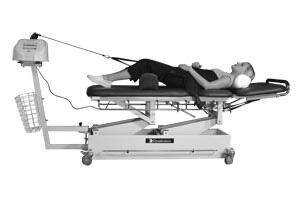Since ancient times, traction has been used by many cultures for the treatment of spinal pain and deformity. However, it was in 1789 that Jean-Andre Venel of Switzerland introduced the extension bed for scoliosis treatment by traction and countertraction in the horizontal position. Venel used a tight cap with a hook and armpit loops, all fixed to the head of the bed, for traction and a pelvic girdle with straps, fixed to the lower end of the bed, for countertraction.
In 1810 the German physician D Schreger developed the modern looking spinal traction bed. The device had a waist-belt and a head halter. The pelvic end was fixed and the spinal distraction was performed by neck traction. Schreger’s invention did not attract immediate medical attention. But in 1825 CA Maisonabe designed nearly the same bed. Schreger counted his device as a short-term procedure, but Frenchman Maisonabe offered it for long-term purposes. He tried to make his device more comfortable and advertised it with a female patient reading a book. At the same time the English physician D Shaw designed a traction bed with sliding frame and weights.
James Cyriax popularised lumbar spinal traction during the 1950’s and 1960’s as a treatment for intervertebral disc protrusions and working alongside physiotherapists, supported traction in their practise. The traction bed became a fixture for all facilities in the 20th century but as research in the latter part of the century found little evidence of its effect, the machines have fallen into disuse and the scrapheap.
Description provided by Susan Waller of United Arab Emirates

